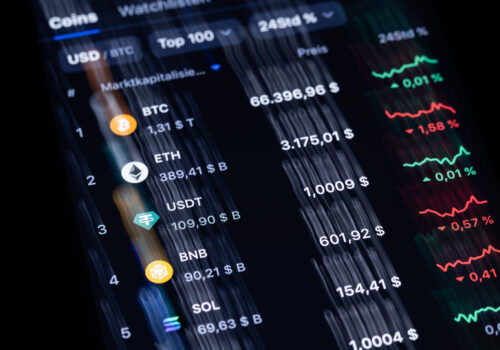Stablecoins are trending, but what frictions and risks are getting overlooked?
The world is enthusiastic about stablecoins. Circle*, the issuer of the $62 billion USDC stablecoin, completed its initial public offering earlier in June and just applied for a banking license. Stripe, by acquiring the Texas-based company Bridge, now enables its business customers to hold, send, and receive stablecoins. Visa has unveiled a bank stablecoin issuance platform, and major non-financial firms like Amazon and Walmart are reportedly considering stablecoin issuance. On June 17, the US Senate passed the GENIUS Act, the country’s first federal regulation for stablecoins backed by the US dollar (USD), and the bill is heading for approval in the House of Representatives.
Stablecoins have established their value as a medium of exchange within the land of decentralized finance and cryptocurrency investing. Today’s total stablecoin market cap is about $255 billion (of this, 99 percent is in USD-denominated stablecoins). With all the new regulatory and industry activity in the space, market participants and industry leaders appear to be expecting large-scale stablecoin adoption for use in domestic and international payments. Yet, stablecoin usage is complicated for consumers, and large-scale adoption would entail macro-financial risks.
Nine challenges to widespread stablecoin adoption may be getting overlooked in all the excitement.
Frictions and risks for users
- Network transaction fees: When stablecoins are sent over a blockchain network, they are typically subject to variable network transaction fees (such as “gas” in Ethereum), just as other cryptocurrency transactions are. These fees compensate the decentralized network of validators who approve of transactions and maintain the security of the blockchain. In simple terms, sending a stablecoin, whether domestically or abroad, usually requires the user to pay a variable transaction fee. Do the future users of stablecoins intend to pay fees for every transaction?
To be fair, centralized payment systems often require a service fee that is paid to the network operator, although this is generally born by banks (who may pass fees on to merchants) rather than by retail end-users in domestic contexts. There are also possibilities for users to side step blockchain transaction fees, such as by employing a “layer 2” network. This network is an add-on transaction layer that waits to settle a sender and receiver’s netted or batched transactions on the main blockchain to reduce fees and improve throughput. While it can be effective, it does add complexity and lower the security of the transaction, all else equal.
Rather than sender transaction fees, some blockchains compensate validators by subsidizing from other sources or by paying a higher “block reward,” which is an automated generation of new cryptocurrency paid to the validator. Regardless, a secure, decentralized transaction validation process has economic costs. Stated more pointedly in a recent Bank for International Settlements report, “the more stringent the degree of consensus needed, the more wasteful the rents required.” - Fragmentation of money and wallet acceptance: From a practical and technical perspective, stablecoins fragment the money in your wallet. A user cannot combine stablecoin balances into one sum or combine these balances with their other currency holdings, unless they convert them in an exchange. This may be fine if someone holds a few types of stablecoins, as people today may have a few bank and e-money accounts. Yet with numerous banks and other institutions considering issuing stablecoins, one must question whether people would really hold multiple stablecoins at once, and why.
Moreover, stablecoins are issued on diverse blockchain platforms with formats that are not always compatible with all wallets. Sending money to an incompatible wallet that cannot accept the stablecoin can, from a technical perspective, lead to losing control of funds. Many closed-loop payment networks today—such as PayPal and many e-money providers like Venmo in the United States—only enable payments to users of that service. Yet, the user can’t make the mistake of sending such funds in the first place. - Fraud risks: The immediate and irrevocable nature of stablecoin (and other cryptocurrency) payments raises the risk of fraud. There is little time to pre-screen transactions or to block or reverse them after a mistake has been made or illegal activity detected. These challenges have harmed fast payment system users owing to those systems’ immediate fund transfer. Fraud risks facing both fast payment systems and cryptocurrencies include account credential theft and takeover (“non-authorized” payment fraud), and impersonation, romance scams, and purchase or invoice scams (“authorized” payment fraud). Blockchain analysis company Chainalysis estimates $12.4 billion of fraud across cryptocurrency globally in 2024 and warns of a growing and increasingly professionalized fraud ecosystem.
Fast payment systems are developing processes and best practices to address these risks, such as standardized fraud resolution policies, fraud reporting and information-sharing, dispute resolution and loss recovery rules, and technology for fraud monitoring and confirmation of recipients. Will stablecoin networks develop similar systems? For instance, will US stablecoin customers who experience credential theft and send unauthorized payments have protections like Regulation E that protects users against this risk in payments today? The United States’ Consumer Financial Protection Bureau proposed expanding “Reg E” to stablecoins, but the agency has turned away from consumer protections toward novel digital currency under the Trump administration. Meanwhile the United States’ GENIUS Act does not appear to include meaningful fraud protection measures. - Bank and exchange intermediation: To move from stablecoins to fiat money today (and vice versa), a user needs to open an account at a cryptocurrency exchange that connects to their bank. While feasible in most jurisdictions, doing so adds an extra step to using stablecoins. This is also a major reason why “banking the unbanked” with stablecoins is often a circular proposition; one needs a bank account to move out of stablecoins into fiat currency. Regulated cryptocurrency exchanges, like banks, also require identifying information as part of a regulatory know-your-customer process, which can pose inclusion challenges to those lacking government-issued documentation.
If banks issue stablecoins in the future, they may sidestep the need to engage with a cryptocurrency exchange. But banks remain in the picture. They also may seek income by charging fees to users for converting their stablecoins to and from bank deposits. - Limits to cross-border remittance savings: Stablecoins are often described as a silver bullet for reducing international remittance costs. Yet, they still involve an irreducible foreign exchange conversion cost. Moving from USD deposits to a USD stablecoin does not involve a foreign exchange transaction, but moving from a USD stablecoin to, say, Turkish lira would. Coupled with the user-facing requirements mentioned above—bank and potentially cryptocurrency exchange accounts, identification documentation, network transaction fees, and the need to critically avoid mistakes or fraud when sending funds—stablecoins’ superiority as a cost and inclusion solution to cross-border remittances is far from self-evident.
Economic challenges and risks
- Bank deposit and liquidity challenges: When a customer acquires stablecoins at the cost of their bank deposits, that bank will see a drop in retail deposits, which are a sticky, inexpensive source of capital for banks to conduct their lending activities. Crowding out deposits could thus dampen lending activity. Still, depending on the jurisdiction, stablecoin issuers can be required to keep funds backing the value of their issued stablecoins at regulated depository institutions. In this case, lost retail deposits return to banks (although not necessarily the same ones). However, they constitute unsecured wholesale funding, which can be volatile and weaken a bank’s liquidity coverage ratio. A run on stablecoins implies rapid withdrawal of these funds, posing stability risks to banks. Additionally, as with other wholesale entities, a stablecoin issuer expecting illiquidity at a bank may attempt to rapidly withdraw its deposits, as Circle attempted with its $3 billion in deposits at Silicon Valley Bank in 2023.
- Business model risk: The core business model as it stands today of firms issuing stablecoins backed by reserves (Tether, Circle, and others) will face sustainability challenges in environments with lower interest rates. Today, the dominant source of revenue for stablecoin issuers is the yield they earn on their reserves, often in bank deposits or short-term treasury bills. Circle made 99 percent of its revenue from this source in 2024. Lower interest rates will compress this revenue. In some cases, major issuers appear to have misled the public about holding 100 percent cash equivalents, when they were actually holding short-term corporate debt with a higher yield.
- Overseas challenges of dollarization and sanctions evasion: Some enthusiasts are excited about the idea of perpetuating US dollar usage abroad with USD stablecoins. However, this overlooks serious risks to the foreign country. Unintended dollarization, or more generally, currency substitution, can harm the country by reducing the effectiveness of its monetary policy for managing business cycles. Namely, the local central bank would normally be able to manage the cost and value of its currency as one tool to provide relief in recession. This is less effective when households and firms hold less of this currency.
The use of stablecoins today to circumvent sanctions should also be noted. Tether’s USD stablecoin, for instance, has reportedly enabled billions of dollars in sanctions evasion globally.
Because of the risks of illegal activity, including the evasion of sanctions and other capital flow management measures, currency substitution, and other challenges, authorities abroad may take measures to limit stablecoin usage in foreign currency in their jurisdictions. In Europe, the MiCA stablecoin regulation enables authorities to restrict non-euro stablecoin usage in the region if it interferes with monetary sovereignty, monetary policy, or financial stability. - Deviation from par value (de-pegging): Today, a dollar is a dollar. With bank oversight and deposit insurance, we don’t question the issuer’s safety before receiving payment. Strong stablecoin regulation would ideally provide similar confidence. However, stablecoins are pegged to dollars—they aren’t dollars themselves, and this peg could break. Numerous stablecoins have temporarily lost their pegs in secondary market trading. Circle’s USDC briefly de-pegged in 2023 due to Silicon Valley Bank concerns, where it held deposits. In a more extreme example, TerraUSD, an algorithmically managed stablecoin, was the fourth-largest in the world with an $18 billion market cap before its collapse in 2022.
This challenge recalls the free banking era when recipients questioned the currency issuer’s brand and strength—a practice we’ve since left behind. The question is whether the benefits of stablecoins outside of cryptocurrency investing—a case still in development—are worth this and other notable challenges.
With more than $250 billion in market cap, stablecoins have proven useful for cryptocurrency investing. As the ecosystem evolves, their value for everyday payments remains to be seen. While there’s considerable excitement about this potential, the dialogue often overlooks significant frictions, risks, and inefficiencies involved with large-scale stablecoin adoption.
Ashley Lannquist is a contributor at the Atlantic Council and former Digital Finance Expert at the International Monetary Fund.
*Note: Circle is a partner of the Atlantic Council’s GeoEconomics Center. This article, which did not involve Circle, reflects the author’s views.

At the intersection of economics, finance, and foreign policy, the GeoEconomics Center is a translation hub with the goal of helping shape a better global economic future.
Further reading
Tue, Jun 3, 2025
For dollar-backed stablecoins to be truly stable, the US needs to set international standards
New Atlanticist By Josh Lipsky
The current patchwork of regulations around the globe creates more confusion, more friction in payments, and ultimately higher costs for consumers.
Wed, Feb 12, 2025
Central bank digital currencies versus stablecoins: Divergent EU and US perspectives
Econographics By Barbara C. Matthews, Hung Tran
All policymakers agree on one point: both CBDCs and stablecoins will significantly impact the global role of the US dollar.
Thu, May 22, 2025
Gold’s geopolitical comeback: How physical and digital gold can be used to evade US sanctions
New Atlanticist By Kimberly Donovan, Maia Nikoladze
The rise of gold-backed currencies that circumvent the US banking system could create a massive blind spot for US sanctions enforcement efforts.



